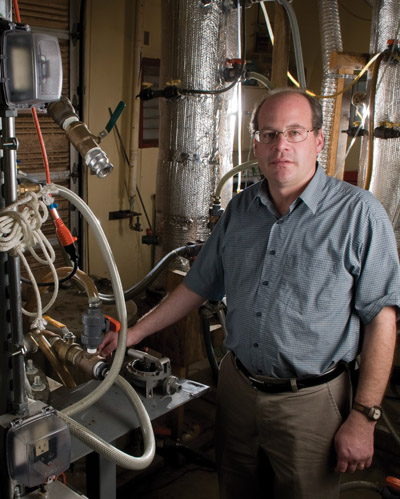
Features
Regional
Regulations
Anaerobic digestion facility opens at MSU
September 23, 2010 by manure manager
The new Anaerobic Digester Research and Education Center (ADREC)
facility on the Michigan State University (MSU) campus will advance the
science and technology of anaerobic digestion (AD) through cutting-edge
research, and will play a key role in expanding Michigan’s bio-economy.
The new Anaerobic Digester Research and Education Center (ADREC) facility on the Michigan State University (MSU) campus will advance the science and technology of anaerobic digestion (AD) through cutting-edge research, and will play a key role in expanding Michigan’s bio-economy.
 |
|
| MSU researcher Steven Safferman with an anaerobic digester of the sort his team hopes to mate with power generators to produce power from animal waste. Photo by G.L. Kohuth
|
“Anaerobic digestion has proven to be a feasible technology to convert waste to resource while minimizing negative impact on the environment,” said Ajit Srivastava, chairperson of the Department of Biosystems and Agricultural Engineering. “However, due to the high cost, it can only be afforded by large dairy operations. Therefore, the goal of the ADREC is to develop off-the-shelf anaerobic digestion technology so it becomes cost effective for small to medium-size farms (200 to 499 milking cows). Since there are more than 2,200 dairy farms in Michigan that fall in this range, the potential of AD technology in converting animal manure to energy, all-the-while reducing green house gas emissions, is huge.”
Even more, the facility brings MSU’s research resources together under one roof.
“This facility actually brought together resources that we had spread across four different laboratories on campus,” said Dana Kirk, who will manage the facility. “By building this facility, we’re able to bring those researchers, the graduate students, the undergraduates and the faculty and staff together under one roof where we can share instrumentation and work back and forth and share resources.”
Anaerobic digesters take waste from livestock and store it in a tank that is deprived of oxygen. This allows the waste materials to decompose quickly, and produces methane that can be used as biogas. Biogas is composed primarily of methane, a greenhouse gas 21 times more potent than carbon dioxide. Emitted from digesters, biogas is collected and used to produce electricity, heat or vehicle fuel.
Construction on the ADREC was started in September 2009 and was completed this spring. The building is a 6,000-square-foot facility. Laboratories, conference rooms and offices for researchers comprise 3,000 feet of the building. The other half of the city is comprised of a high bay for pilot-scale research projects.
“Several anaerobic reactors, ranging in size from two liters to 200 liters, are housed in the high bay section of the facility,” Kirk said. The high bay portion of the facility also features a temperature-controlled room, which is vital to work with anaerobic digestion.
“We think MSU can play a very critical role in this industry as it evolves in this country because of the research we have both in the faculty, staff and now in the laboratory facilities,” said Steven Safferman, associate professor of biosystems and agricultural engineering.
It’s not just a hunch that Safferman’s playing either.
Recently the United States Environmental Protection Agency (EPA) and the United States Department of Agriculture (USDA) announced a new interagency agreement promoting renewable energy generation and slashing greenhouse gas emissions from livestock operations.
The agreement expands the work of the AgStar program, a joint EPA-USDA effort that helps livestock producers reduce methane emissions from their operations. The collaboration provides $3.9 million over the next five years, expands technical assistance efforts, improves technical standards and guidance and expands outreach to livestock producers to assist with pre-feasibility studies.
The EPA estimates that there are currently 150 on-farm manure digesters now operating at livestock facilities across the country. In addition, the EPA estimates there are about 8,000 farms across the country that could be good candidates for capturing and using biogas.
If all 8,000 farms implemented biogas systems, methane emissions would be reduced by more than 34 million metric tons of carbon dioxide equivalent a year – roughly equal to the annual emissions from 6.5 million passenger vehicles. In addition, these projects could generate more than 1,500 megawatts of renewable energy.
“The methane gas can be used for any of our conventional energy sources,” Kirk said. “It can be used to directly replace natural gas – if we scrub out the impurities – it actually can be inserted in the pipeline and burned at your house. Typically and historically, methane gas has been converted into electricity by using it as the fuel source for a turbine or an internal combustion engine.”
The ADREC will work with the MSU Dairy Teaching and Research facility to collect manure from the barns and turn it into biogas. Additionally, Kirk said, the facility will collect other forms of waste to turn into gas. Researchers will experiment with food scraps from the Brody cafeteria, but they’re also testing different materials for numerous commercial clients.
The working model at MSU is serving as a model for the rest of the industry, Kirk said. The ADREC has been contracted by several private organizations to perform independent testing on different materials and will serve as a working classroom for MSU students.
“Instead of waste being an environmental burden to the environment, it now becomes an asset and a very much needed commodity,” said Safferman.